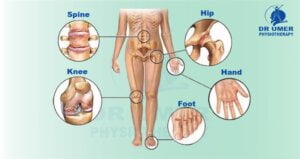Osteoarthritis the word ‘osteo’ means bone, ‘arthr’ means joint and ‘itis’ means inflammation. Osteoarthritis is a very common long-term condition. It can happen at any age but commonly develops after the age of 50. In fact, many people as they get older will develop a degree of osteoarthritis in their joints, and around 20-30% will experience symptoms. It is also more common in women than men, and may run in families.
Joints are places where two bones meet, like as the knee or elbow. In-between the bones are smooth, tough and slippery material called cartilage, which cushions the bones, and a joint capsule, which is filled with fluid. During normal daily activities, our joints under-go low levels of stress and injury, which are usually repaired.
In osteoarthritis, however, the cartilage wears down over time and the joint surface becomes rougher and leading to inflammation. Bony growths can develop around the joint, and fluid can grow up, causing swelling.
Symptoms of Osteoarthritis
The symptoms of osteoarthritis are different from person to person. For some, the symptoms come and go, sometimes for without reason, sometimes after using the joint, or with changes in the weather. For others, the pain is more continuous and severe, making it difficult to do normal daily activities.

- Joint pain and tenderness; is normally worse at the end of the day or after exertion.
- Joint stiffness; usually happens after resting, but it’s better on movement.
- The joint may appear enlarged or swollen, or may make crackling sounds.
- Muscle thinning and weakness can occur and the patient not able to move.
Risk Factor
Risk factors include:
- Overweight or Obese
- Previous joint injury
- Overusing a joint
- Diabetes
What parts of the body do Osteoarthritis affect?

It can affect mostly are;
Knee
Osteoarthritis in knee happens when the cartilage in knee joint breaks down and the joint surface become rougher.
Hip
Hip joint is the second leading joint in osteoarthritis. It’s related by aging and aggravates by time.
Hands
In hand, the DIP (Distal Inter-Phalangeal) and the PIP (Proximal Inter-Phalangeal) joints usually affected when the patient gets older.
Feet
Osteoarthritis in feet patients facing balance problems and also pain in foot commonly worse at night.
Lower back
Degenerative changes in vertebrae are very painful and also restrict the movement of the lower part.
How a Physical-Therapist helps you?
Physiotherapist may recommend structured exercises and weight loss plan to get you started and provide tips on good posture and leading a healthy lifestyle. Occupational therapists can also help you to manage daily routine work.
Living with osteoarthritis can be difficult, especially when you are not able to do on work and daily activities. Assistive devices can be helpful, like special footwear or insoles, walking aids and splints or braces.
Physiotherapist can usually diagnose osteoarthritis just by hearing about your symptoms. If he is not sure about what is causing the joint pain, they may use imaging and lab tests such as X-rays or blood tests, to rule out other conditions.


